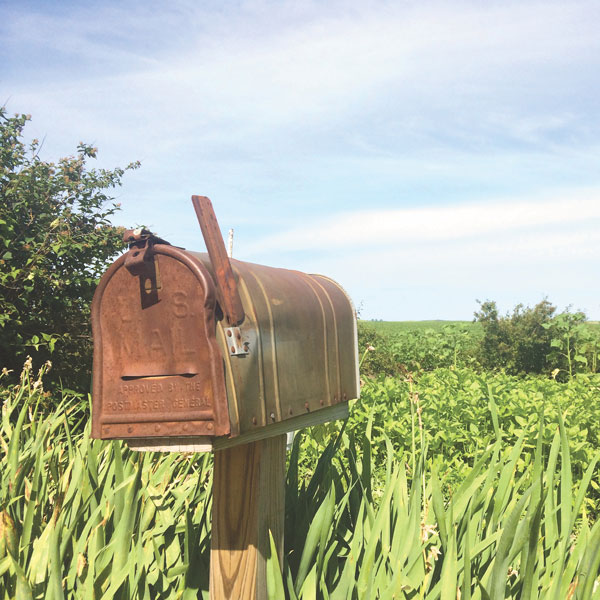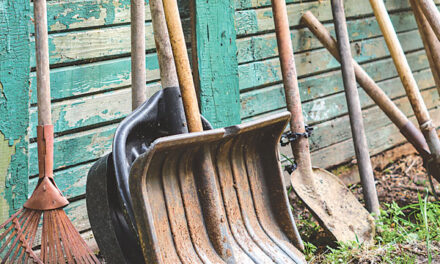Wacky gardening tools are lurking in dark corners of garages, kitchen drawers, yard sales and local stores. The tool arsenal is more than pricey pruners, digging forks and hand trowels.
One fine morning I stopped at a yard sale in East Sacramento. I spotted two old school metal mailboxes, the type with the red flag that signifies outgoing mail. Both were purchased for a grand total of $5. They are extremely useful for tool storage in a main garden area and will save countless trips back to the house, shed or garage for a needed tool. Mount them on a post for the true postal experience. Stow gloves, hand pruners, and other small gear and accessories.

A common lament of frustrated gardeners goes like this: “Something is eating my plants, but I can’t find any bugs.” Light ’em up with a flashlight.
Flashlights are not just for Sacramento’s winter storm emergencies. When darkness falls, shine a beam of light on plants under attack. Nocturnal feeders include earwigs, slugs and snails. Some caterpillars feed at night, too. During daylight hours, these destructive pests hide under boards, nearby pots or in the soil. Inspect the underside of leaves.
A UV black light used at night will make tomato foliage appear reddish-orange and those hard-to-find tomato hornworms a standout bright green. Gotcha!
Readers squeamish about handpicking or stomping on garden pests can wear gloves and brush the destructive munchers into a container of soapy water. At ground level, empty tuna or cat food cans filled with a half-inch of vegetable oil will lure and doom earwigs.
If insecticides are used, make sure you have a positive ID of the pest, use a pesticide (hopefully organic) that targets your specific pest and follow all label instructions. When unsure of the pest, take a bagged sample to the neighborhood nursery or send an email and photo of unknown pests to the UC Master Gardeners of Sacramento County at mgsacramento@ucanr.edu.
The common wood and metal-hinged clothespin is an inexpensive and valuable gardening tool. A couple dozen will set you back a buck at the Dollar Store. Use them to attach shade cloth during Sacramento’s hottest months and secure frost covers to tender plants, such as citrus and avocado trees, succulents and tropical plants, when freezing temperatures are forecast.
An old wire brush—the type with a paint scrapper on the back and stiff wire bristles—has kept the peace in my home. Gardeners wear an assortment of footwear, clogs, crocs, “wellies” and more. However, if you shun the appropriate footwear or are inclined to venture outside for a brief bit of gardening in running shoes, a wire brush will remove any debris, even on waffle soles. The exception is a ripe fig, nature’s equivalent to stepping on bubble gum.
The humble heavy-duty tarp, made from canvas or polyethylene, can be extremely useful when repotting large and small container plants. Repot atop the tarp for easy cleanup. I use a tarp when transplanting large perennials to a different location. Lay the plant and root ball on the tarp and drag to the new planting site. Tarps also can be used to cover compost piles, create new planting areas (a covered area will kill weeds and turf grass) and protect outdoor furniture in winter.
Mostly associated with kabobs on the grill, bamboo skewers can support orchids in danger of toppling because of an ailing root system. Pushed into the growing medium, skewers will align the plant and, hopefully, support it while new roots form. They also support bloom stalks.
Old T-shirts can be used for slings. If you visit the Fair Oaks Horticulture Center, you may notice cut-up T-shirts used as supportive slings for melons grown on trellising. Each melon swings in its own “hammock.”
Dan Vierria is a University of California Cooperative Extension Master Gardener for Sacramento County and former Home & Garden writer for The Sacramento Bee. He can be reached at masterg29@gmail.com. For answers to gardening questions, contact the UCCE Master Gardeners at (916) 876-5338, email mgsacramento@ucanr.edu or visit sacmg.ucanr.edu. Follow us on Facebook, Twitter and Instagram: @insidesacramento.















